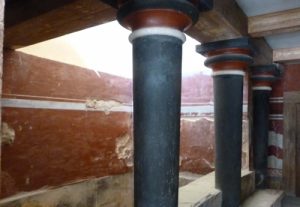The archaeological site of Knossos

Evidence shows that this area was inhabited in Neolithic times (6000BC) and it was on the ruins of the Neolithic settlement that the first Minoan palace was constructed in around 1900 BC. This first palace was destroyed 200 years later and a new palace was built to replace it which covered around 22,000 square metres.
The palace was several storeys high and very intricate in its design, a labyrinth of corridors, store rooms, sanctuaries, ceremonial rooms, the majestic throne room, the royal quarters, the room of the giant pithos and the theatre.

The archaeological site itself comprises the several remains of buildings. It is assumed that the ancient inhabitants chose that position for its proximity to Mount Ida, a sacred place where, according to their cult, Zeus was hidden by his mother Rhea so as not to have him devoured by his father, the titan Cronus.
As well as the Great Palace, the largest building, there are also the well preserved remains of the Little Palace, the House of the Priest, the Caravanserai (which was the public baths) the Royal Tomb, and the House of Dionysos with its superb mosaic floors.
Welcome to the Labyrinth

But that’s much better than finding the legendary denizen of these corridors, the half-man, half-bull Minotaur said to once be confined within the heart of the palace, the illicit offspring of a mating between Queen Pasiphae and a royal bull she was cursed into loving. Here the hero Theseus was protected by the brave Minoan maiden Ariadne, daughter of King Minos, who gave him a piece of string to find his way back through the tangle of hallways. Alas for Ariadne, Theseus later abandoned her to the embrace of Dionysus on the island of Naxos, or, much less coldly, put her ashore to recover from seasickness and then was swept away from her by a strong wind. With family stories like these, no wonder the atmosphere of Knossos is disturbing.

At the time that Knossos was most powerful, Greek cities looked up to Crete. Tribute was sent, in the form of produce and gifts, and, if the legend is correct, young men and women. Additional excavations suggest that Knossos presided over a city of 100,000 people – huge by ancient standards, though Crete itself was known to be densely populated by comparison to the rest of the Grecian world.
Don’t Miss in Knossos

Aside from the “Horns of Consecration” -a name given them by Evans – the other symbol of the Minoans is the labrys. The mystery of the Minoans remains in this symbol, sometimes depicted as a double-edged tool of war, sometimes as a butterfly. There is a debate of opinion between whether the Minoans were immensely peaceful -their palaces have very poor defenses- or if they were such efficient warriors on forays outside their island that no one dared to attack them on their own territory. Wielders of the axe or admirers of the butterfly – visit Knossos and wonder for yourself.
How to Get to Knossos
Drive about two miles south from the center of Heraklion (Iraklio), on the road to Archanes. Knossos is on the east side of the road; watch for signs and, more reliably, increased congestion and tour buses. Many cruise ships also offer day trips to Knossos when they are in port; try to combine your visit with a visit to the Archaeological Museum of Iraklion, which is second only to the National Archaeological Museum in Athens and well worth seeing.
The Number 2 bus from the main station at the port and from Plateia Eleftherios and other locations also goes to Knossos; if time permits, this may be a much cheaper option than taking the tour from the ship, though you may risk ending up on your own without a guide.
Facilities
Hungry? There are several surprisingly decent little snack shops, with attendant souvenir racks, directly across the road from Knossos. Keep an eye out for the gift shop offering an extensive collection of inexpensively-priced reproductions of Minoan finds. The ceramic reproductions of the faience snake goddess found at Knossos are much too new looking, despite the welded lead seal asserting that they are official, authentic reproductions, but they’re the best you’ll see anywhere.
Knossos Admission
7.5 Euro; a special package allows you to visit the Iraklion Archaeological Museum and Knossos for just 10 Euro.
